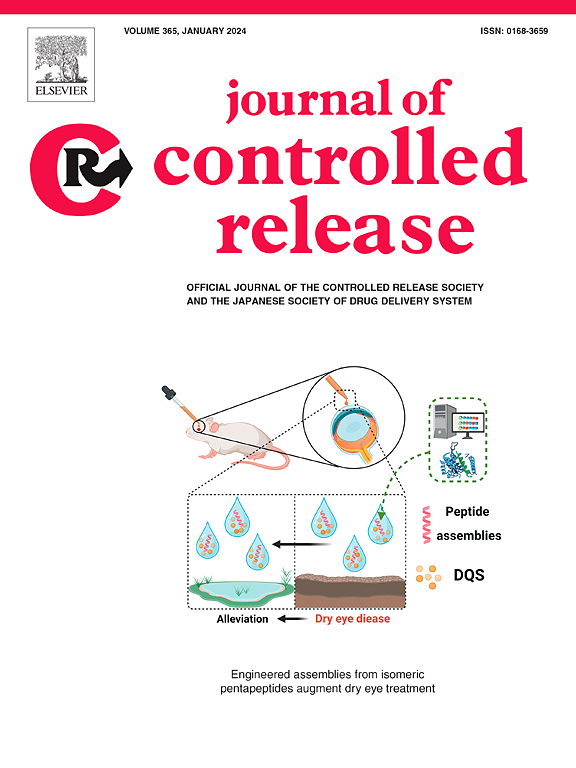Microneedle-adapted PAMAM-BSH delivery facilitates spatiotemporal matching for melanoma boron neutron capture therapy
IF 10.5
1区 医学
Q1 CHEMISTRY, MULTIDISCIPLINARY
引用次数: 0
Abstract
Boron Neutron Capture Therapy (BNCT) is a binary radiotherapy based on the combination of 10B drugs and thermal neutrons. Coordinating 10B with neutron irradiation will optimize the efficacy of BNCT, but further improvements are still required. Here, we develop a delivery system incorporating microneedles (MNs) and a modified boron agent PAMAM-BSH, enabling precise spatiotemporal matching of 10B with neutron irradiation for melanoma BNCT. The PAMAM-BSH is a cationic polymer 10B agent with amphiphilicity, forming nanomicelles in an aqueous solution. It exhibits high boron content and demonstrates good uptake and retention capabilities in cancer cells. When administering PAMAM-BSH-loaded MNs to melanoma-bearing mice, the duration for which the 10B content in tumors exceeds 20 ppm can extend up to 2 h. Notably, the system facilitates the precise administration of 10B into tumor cells, achieving concentrations exceeding 35 ng 10−6 cells. These contribute to an excellent alignment of spatiotemporal matching of 10B with neutron irradiation in BNCT. Meanwhile, the T/N (tumor-to-normal tissue) and T/B (tumor-to-blood) ratios can reach 30 and 100, respectively, which are much higher than the clinical BPA (T/N is 1.1–2.9, T/B is 1.1–3.6). Utilizing the system ultimately demonstrated a significant enhancement in melanoma BNCT, along with improved safety.

微针适应PAMAM-BSH递送促进黑色素瘤硼中子捕获治疗的时空匹配
硼中子俘获疗法(BNCT)是一种基于10B药物与热中子相结合的二元放射治疗。将10B与中子辐照相协调将优化BNCT的疗效,但仍需进一步改进。在这里,我们开发了一种包含微针(MNs)和改性硼剂PAMAM-BSH的递送系统,使10B与中子照射在黑色素瘤BNCT中的精确时空匹配成为可能。PAMAM-BSH是一种具有两亲性的阳离子聚合物10B剂,在水溶液中形成纳米胶束。它具有高硼含量,并在癌细胞中表现出良好的吸收和保留能力。当给携带pamam - bsh的MNs给瘤小鼠时,肿瘤中10B含量超过20 ppm的持续时间可延长至2 h。值得注意的是,该系统有助于将10B精确地施用到肿瘤细胞中,达到超过35 ng 10−6细胞的浓度。这有助于在BNCT中实现10B与中子辐照的时空匹配。同时,T/N(肿瘤与正常组织之比)和T/B(肿瘤与血液之比)可分别达到30和100,远高于临床BPA (T/N为1.1-2.9,T/B为1.1-3.6)。使用该系统最终证明了黑色素瘤BNCT的显著增强,同时提高了安全性。
本文章由计算机程序翻译,如有差异,请以英文原文为准。
求助全文
约1分钟内获得全文
求助全文
来源期刊

Journal of Controlled Release
医学-化学综合
CiteScore
18.50
自引率
5.60%
发文量
700
审稿时长
39 days
期刊介绍:
The Journal of Controlled Release (JCR) proudly serves as the Official Journal of the Controlled Release Society and the Japan Society of Drug Delivery System.
Dedicated to the broad field of delivery science and technology, JCR publishes high-quality research articles covering drug delivery systems and all facets of formulations. This includes the physicochemical and biological properties of drugs, design and characterization of dosage forms, release mechanisms, in vivo testing, and formulation research and development across pharmaceutical, diagnostic, agricultural, environmental, cosmetic, and food industries.
Priority is given to manuscripts that contribute to the fundamental understanding of principles or demonstrate the advantages of novel technologies in terms of safety and efficacy over current clinical standards. JCR strives to be a leading platform for advancements in delivery science and technology.
 求助内容:
求助内容: 应助结果提醒方式:
应助结果提醒方式:


